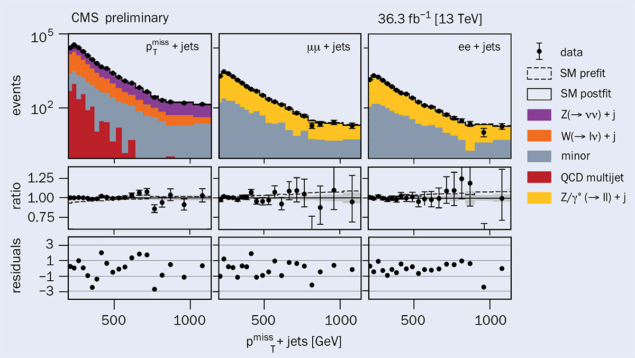A report from the CMS experiment.

The LHC was built in the 27 km tunnel originally excavated for LEP, the highest energy electron–positron collider ever built. Designed to study the carriers of the weak force, LEP’s greatest legacy is the accuracy with which it pinned down the properties of the Z boson. Among the highlights is the measurement of the Z boson’s invisible width and decay branching fraction, which was used to deduce that there are three, and only three, species of light neutrinos that couple to the Z boson. This measurement of the Z-boson invisible width from LEP has remained the most precise for two decades.
This precise measurement of the Z-boson invisible width is the first of its kind at a hadron collider
In a bid to provide an independent and complementary test of the Standard Model (SM) at a new energy regime, CMS has performed a precise measurement of the Z-boson invisible width – the first of its kind at a hadron collider. The analysis uses the experimental signature of a very energetic jet accompanied by large missing transverse momentum to select events where the Z boson decays predominantly to neutrinos. The invisible width is then extracted from the well-known relationship between the Z-boson coupling to neutrinos and its coupling to muons and electrons.
While the production of a pair of neutrinos occurs through a pure Z interaction, the production of a pair of charged leptons can also occur through a virtual photon. The contribution of virtual photon exchange and the interference between photon and Z-boson exchange are determined to be less than 2% for a dilepton invariant mass range of 71–111 GeV, and was accounted for to allow the collaboration to compare the results directly to the Z’s decay to neutrinos.
Figure 1 shows the missing transverse momentum distribution for the three key regions contributing to this measurement: the jets-plus-missing-transverse-momentum region; the dimuon-plus-jets region; and the dielectron-plus-jets region. For the dilepton regions, selected muons and electrons are not included in the calculation of the missing transverse momentum. The dominant background to the jets plus missing transverse momentum region is from a W boson decaying leptonically, and accounts for 35% of the events. Estimating this background with a high accuracy is one of the key aspects of the measurement, and was performed by studying several exclusive regions in data that are designed to be kinematically very similar to the signal region, but statistically independent.
The invisible width of the Z boson was extracted from a simultaneous likelihood fit and measured to be 523 ±3 (stat) ±16 (syst) MeV. This 3.2% uncertainty in the final result is dominated by systematic uncertainties, with the largest contributions coming from the uncertainty in the efficiencies of selecting muons and electrons. In a fitting tribute to its predecessor and testament to the LHC entering a precision era of physics, this measurement from CMS is competitive with the LEP combined result of 503 ± 16 MeV and is currently the world’s most precise single direct measurement.
Further reading
ALEPH Collab. et al. 2006 Phys. Rep. 427 257.
CMS Collab. 2021 CMS-PAS-SMP-18-014.







